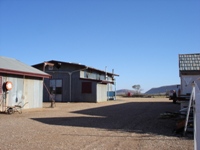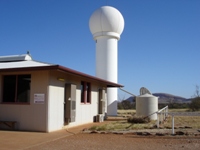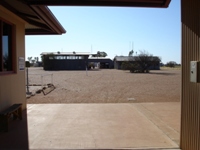Australia So Much to See


1. The Giles Weather Station was established in 1956 by the Weapons Research Establishment (now known as the Defence Science and Technology Organisation), a division of the Department of Defence. The first weather observations were transmitted from the station by radio on 2 August 1956.
2. The purpose of the station was to provide weather data for the
3. The station has a staff of four who run it on a six-month tour. The staffing is arranged by the South Australian
Regional Office of the Bureau of Meteorology and the Observing staff come from various Bureau offices throughout
4. Situated
about 750 kilometres west-southwest of Alice Springs, just over the West Australian Border, on the edge of the Gibson Desert, south
of the
5. Giles is the resting place of the Caterpillar grader which was used to build the
6. Giles Weather Station
is a modern fully equipped station which carries out a full range of meteorological observations, including upper atmosphere observations
using balloon flights and radar tracking. It is the only staffed weather station in an area of about 2.5 million square kilometres.
Its location near the core of the subtropical jetstream makes the station vital for forecasting over most of eastern and southeastern
7.For many years the weather data collected at Giles was transmitted by HF radio, which posed difficulties when radio reception was
poor. Since 1986, data has been transmitted much more reliably via landline or satellite to
Use your browser back button to return to the page you were reading
Giles Weather Station
Update: With further staffing reductions, tours of the Giles Weather Station are no longer available. The visitor room will remain open to the public, and the weather balloon releases can be observed from the car park. Times for the balloon releases remain the same as hereunder.
Please phone the station before you visit on 08 8956 7358 to see what is available. Covid restrictions may apply 2020/2021.
Due to changes in staffing, these informative and interesting tours of the weather station
have been changed. Watching the release of the weather balloons will no longer be part of the tour and can only be seen from
the car park. This tour in its full form was the highlight of our trip across the
Media release from Bureau of Meteorology:
Guided tours of weather station are no longer available
Weather
balloon releases can be viewed daily, looking towards the radar tower, from the car park near the visitors centre, at the following
times:
Non Daylight Savings:
8:45am and 2:45pm. (South Aust. time)
Daylight Savings: 9:45am and 3:45pm. (South Aust. time)
Paul Lainio
Senior Meteorologist,
Media and Community Relations
15 November 2012
Updated 4 May 2021
History of Giles Weather Station published with the permission of South Australian Regional Office of the Bureau of Meteorology


